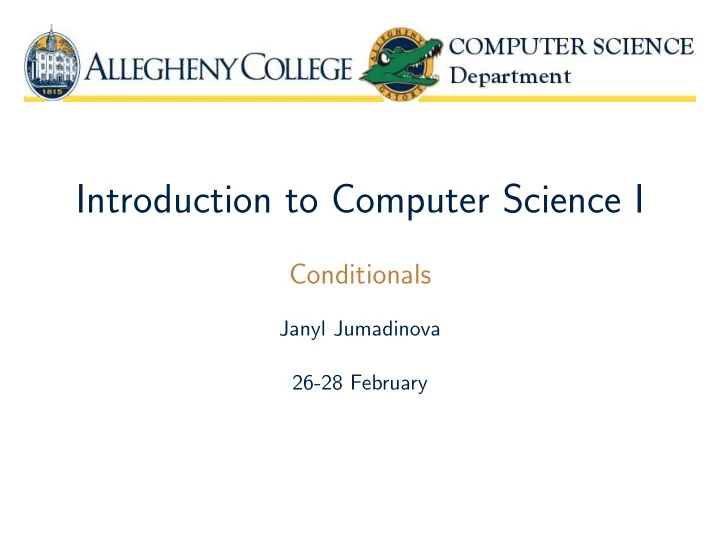

Introduction to Computer Science I Conditionals Janyl Jumadinova 26-28 February
Computational Thinking: a problem solving process ◮ Decomposition ◮ Pattern Recognition ◮ Abstraction ◮ Algorithm Design 2/16
Algorithms ◮ Algorithm is a procedure for solving a problem in terms of the actions to be executed and the order in which those actions are to be executed. 3/16
Algorithms ◮ Algorithm is a procedure for solving a problem in terms of the actions to be executed and the order in which those actions are to be executed. 3/16
Control Structures ◮ We may need to be able to make decisions (selection) and repeat actions (looping) in our programs to allow for more complex programs. ◮ Selection and looping are common to all programming languages. The way they implement these concepts, however, may differ from language to language. 4/16
Control Structures Three Groups of Control Structures 1. Sequential Structure - It is just built into the language itself. 5/16
Control Structures Three Groups of Control Structures 1. Sequential Structure 2. Selection Structures - if : single selection - if/else : double or multiple selection - switch : multiple selection 6/16
Control Structures Three Groups of Control Structures 1. Sequential Structure 2. Selection Structures 3. Repetition Structure while do/while for 7/16
Control Structures ◮ Java programs are built from only these seven control structures: ◮ three selection (if, if/else, switch) ◮ three repetition (while, do/while, for) ◮ You implement computer algorithms by stringing sequences of these seven control structures together. 8/16
if/else ◮ if only has a “do it or don’t do it” mentality – if the assertion is true, you do the associated action, if it’s false, you skip it. 9/16
if/else ◮ if only has a “do it or don’t do it” mentality – if the assertion is true, you do the associated action, if it’s false, you skip it. ◮ The if/else structure gives more flexibility by providing something to do if the assertion is false – the “else” portion of the structure. ◮ Nested if/else structure strings together multiple if/else statements to handle a range of values. 9/16
Which of these code segments will determine a letter grade correctly based on a variable ‘grade’? if (grade < 60) if (grade >= 90) System.out.println("F"); System.out.println("A"); else if (grade >= 60) else if (grade >= 80) System.out.println("D"); System.out.println("B"); else if (grade >= 70) else if (grade >= 70) System.out.println("C"); System.out.println("C"); else if (grade >= 80) else if (grade >= 60) System.out.println("D"); System.out.println("D"); else else System.out.println("A"); System.out.println("F"); 10/16
Compound Statements ◮ What if you wanted to do more than one thing in an if or an if/else action? ◮ Need to use braces ( { and } ) to form a compound statement. 11/16
if and if/else tips to remember: ◮ They can be used to test ranges of values. ◮ In a nested if/else structure, an else always attempts to match up with the closest and most immediately unmatched preceding if statement. ◮ Always use compound statements with if/else structures to prevent problems down the road. 12/16
Logical Operators ◮ Using logical operators, we have a way to string multiple simple conditions together to help avoid/simplify nesting statements. ◮ These logical operators are based on the concept of Boolean logic or Boolean algebra. 13/16
Logical Operators ◮ Using logical operators, we have a way to string multiple simple conditions together to help avoid/simplify nesting statements. ◮ These logical operators are based on the concept of Boolean logic or Boolean algebra. ◮ These are the three logical operators in Java: 1. && (logical AND) 2. || (logical OR) 3. ! (logical NOT, or negation) 13/16
Logical and Truth Table 14/16
Logical or Truth Table 15/16
Logical not Truth Table 16/16
Recommend
More recommend